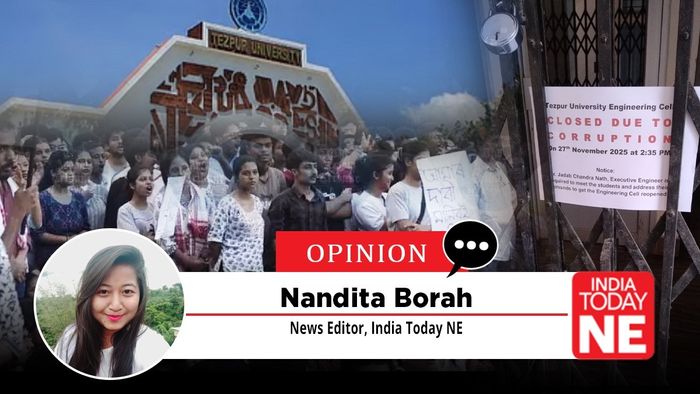A system is rotting
Tezpur University’s campus has become a battleground for change, marked by an unprecedented student-led lockdown that entered its most intense phase on November 27. The growing unrest, now entering its 69th day, signals a profound institutional crisis rooted in allegations of financial irregularities, administrative neglect, and leadership failure. The university community, students, faculty, and staff, has united in demanding accountability at the highest levels, calling for direct intervention by key officials and the Union Ministry of Education.

- Nov 28, 2025,
- Updated Nov 28, 2025, 11:35 AM IST
Tezpur University’s campus has become a battleground for change, marked by an unprecedented student-led lockdown that entered its most intense phase on November 27. The growing unrest, now entering its 69th day, signals a profound institutional crisis rooted in allegations of financial irregularities, administrative neglect, and leadership failure. The university community, students, faculty, and staff, has united in demanding accountability at the highest levels, calling for direct intervention by key officials and the Union Ministry of Education.
Once hailed as a model of discipline and academic vitality in Assam, Tezpur University now stands enveloped in turmoil. The campus gates, traditionally symbols of academic pursuit and open discourse, are shuttered under the resolute grip of its own stakeholders. This lockdown, enforced collectively by the university fraternity, is not a fleeting expression of discontent; rather, it is a manifestation of accumulated frustration fed by months of alleged systemic neglect.
Central to the agitation are demands for the immediate presence of Finance Officer Braja Bandhu Mishra and Chief Executive Engineer Jadav Chandra Nath, who have yet to address long-standing concerns over financial management and infrastructure failures. This insistence reflects the deep mistrust within the campus community, which has grown weary of vague explanations and delayed responses to pressing issues.
The Vice Chancellor, Shambhu Nath Singh, is a focal point of this crisis. His absence from the campus amid escalating tensions and allegations has been perceived as abandonment by many students and staff. The administration’s silence and inertia have only intensified calls for transparent leadership. The demand for appointing an Acting Vice Chancellor by the Union Ministry of Education during the ongoing investigations underscores the urgency to stabilize governance at the helm.
Perhaps the most startling indication of the depth of the university’s crisis emerged publicly when a Deputy Registrar, part of the administrative core, openly sided with the protesters. Her say on this, “All authority rests with the Vice Chancellor. We have no choice but to listen to him. The protest by the students and ours is against the irregularities committed at the highest level” lays bare the scale of administrative dissent and the loss of faith from within.
This internal fracture is compounded by the broader academic community’s alliance with the movement. Professors, employees, and various departments have rallied behind the students, effectively paralyzing the campus’s academic and administrative functions. What began as a protest against the Vice Chancellor’s insensitivity towards a homage event honoring the late singing icon Zubeen Garg on September 21, has now morphed into a full-fledged demand for structural reform.
The ongoing lockdown symbolizes a desperate plea: no classes, no campus movement, no dilution of demands until institutional transparency and accountability are restored. The protesters emphasize that the impasse is not merely about individual grievances but about safeguarding the integrity of an institution meant to foster higher learning and intellectual growth.
In response, the Assam Governor, who serves as the university’s Chancellor, has constituted an inquiry committee aimed at addressing these serious accusations. While this administrative move may soothe some tensions, the university’s fractured spirit and the stark dissent within its corridors suggest the road to reconciliation will be long and complex.
Tezpur University today exemplifies the volatility that emerges when trust between leadership and its community erodes. The unfolding narrative is a powerful reminder that academic institutions are not immune to governance crises and that the restoration of order depends profoundly on transparent, responsive leadership. As Tezpur stands at this crossroads, the nation watches closely: will the university reclaim its legacy of excellence or remain mired in uncertainty?